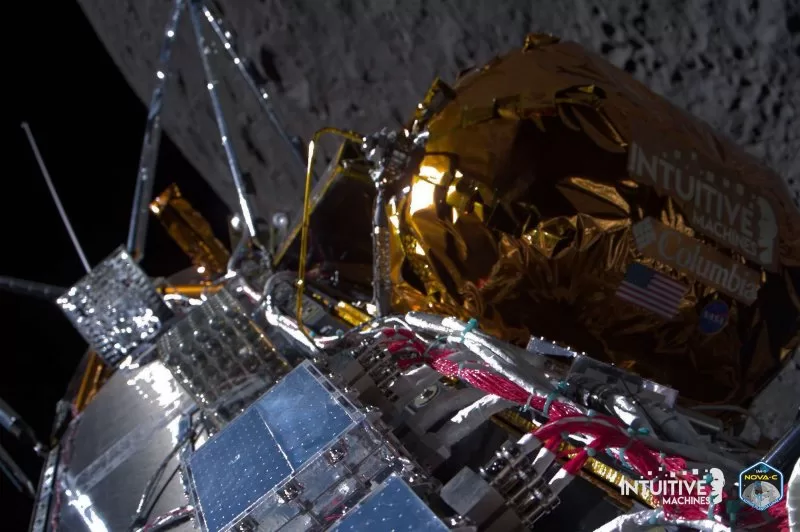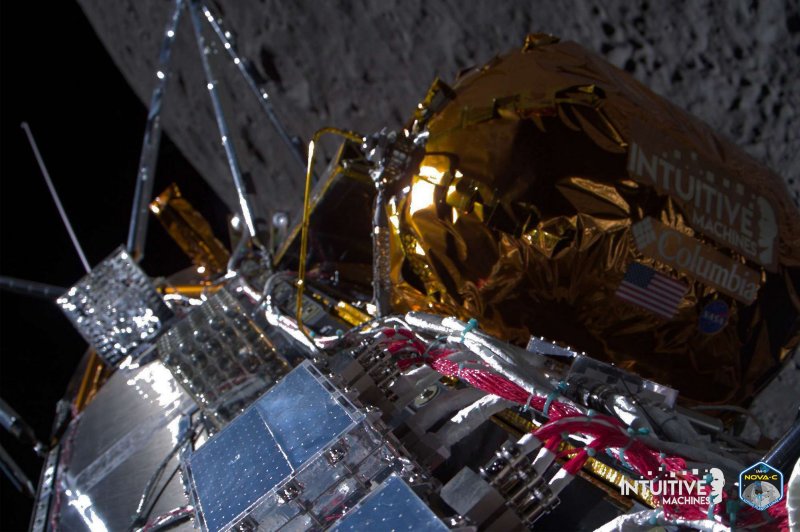Odysseus passes over the near side of the Moon following lunar orbit insertion on February 21. Intuitive Machines’ Odysseus spacecraft became the first U.S. spacecraft and the first commercial spacecraft to land on the lunar surface in 52 years when it touched down on Thursday, February 22, 2024. Photo courtesy of Intuitive Machines/UPI |
License PhotoFeb. 23 (UPI) — Space-industry officials on Friday called Odysseus’ successful moon landing an important step toward sending humans back to the moon.
On Friday, they discussed the details of mission as part of NASA’s Commercial Lunar Payload Services initiative and its Artemis campaign.
The space vehicle landed late Thursday and had a safe and soft touchdown, according to Steve Altemus, chief executive officer and co-founder of Intuitive Machines, the company that contracted with NASA to accomplish the mission.
The vehicle was expected to have sustained some damage during its landing and it is unclear for now how much was sustained, but NASA and Intuitive Machine officials said during Friday’s press conference that, overall, they are very pleased with results so far.
Altemus said it was “quite a spicy seven-day mission to get to the moon,” adding that, despite this, the team members “were cool under pressure.”
It’s the first time the United States has had a new presence on the lunar surface since NASA’s Apollo 11 in July 1969.
Odysseus is stable near or at its intended landing site and there is communication contact with it, he said.
“That’s phenomenal to begin with,” Altemus added.
The Intuitive Machines Odysseus lunar lander, nicknamed “Odie” or “IM-1,” settled on the moon’s surface after a day-long journey. A five-minute delay in communications raised tensions before a safe landing could be confirmed.
Intuitive is in the process of downloading data and trying to get photos, with Altemus saying that engineers have noted “interesting data” on the lander location. The machine has 100 percent state of charge, as well, which he called “fantastic.”
The Odysseus lander is one of many commercial projects being supported by NASA as part of the Artemis Initiative, which supports private space exploration ahead of NASA’s planned Artemis mission, which aims to return humans to the lunar surface.
It has been a “very interesting mission so far,” Altemus said, adding that updates will be made in coming days and a picture will be shared this weekend.
Tim Crain, Intuitive Machines’ chief technology officer and co-founder, called Odysseus a “marvelous machine” and said it was a “magical day.”
The autonomous vehicle flew sideways “with respect to the moon,” he said, then landed on its side moving at 2 MPH and is currently “somewhat elevated” within 2 or 3 kilometers of its originally expected landing site
He said it flew behind the moon and lost signal for 25 minutes until 200 meters above the eventual landing site.
The machine — which had a “perfect” thrust — processed over 10,000 images. Its engines came on 13 minutes before landing.
First steps back to Moon
Joel Kearns, deputy associate administrator for Exploration, Science Mission Directorate at the NASA Headquarters in Washington, D.C., said Odysseus landed much closer to the south pole of the moon than other previous missions.
“We expect to get a lot of data,” he commented.
Kearns said, “We knew we were going back to the moon repeatedly,” adding “this was Intuitive’s first attempt carrying our cargo”
There are advantages to having private industry take the lead on space travel and hinted that timing is ripe for it to continue, he said, and that officials knew there were risks and benefits.
Prasun Desai, deputy associate administrator for the Space Technology Mission Directorate at NASA Headquarters, said “technology drives exploration,” and there has been data collected all throughout transit.
He said this successful mission will allow for NASA to carry out other successful missions with “a lot of development over the years.”
The technology, Desai said, “performed flawlessly” and had a “better than expected performance.”
He added that this successful landing will set the path for other successful missions and, eventually, lead toward landing humans on the moon again.
“This is the first step in allowing that,” Desai said.

